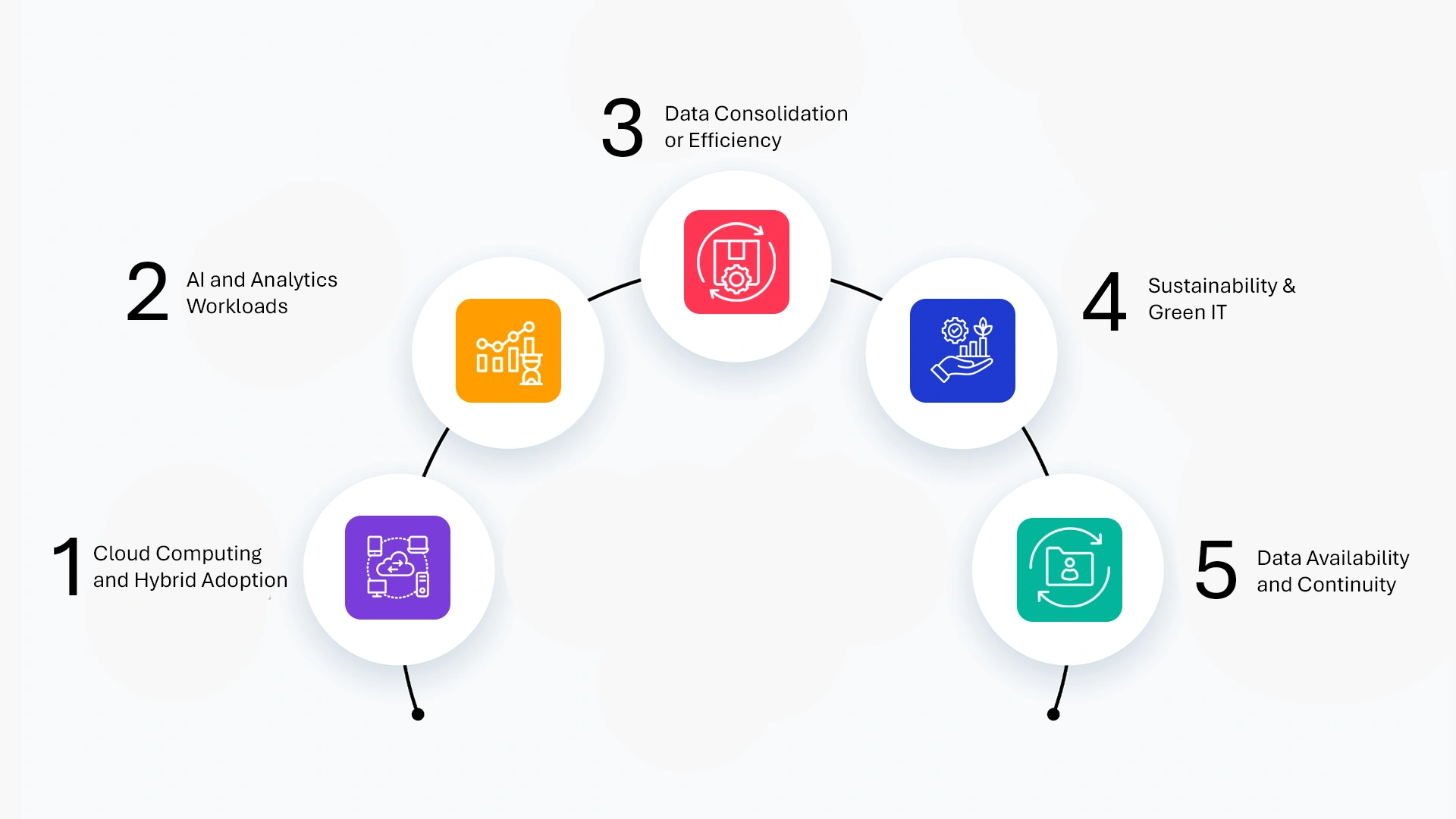Storage infrastructure refers to the foundational ecosystem of hardware, software, networking, and services that enable enterprises to store, manage, and retrieve digital data reliably. In today’s age of exponential data growth—fueled by cloud computing, AI workloads, IoT, and remote collaboration—storage infrastructure forms the digital spine of enterprise IT. It’s no longer just about capacity; it’s about intelligence, scalability, and resilience.
Why Storage Infrastructure Matters in a Cloud-First World
With more than 80% of enterprise workloads expected to shift to the cloud by 2025, organizations are rethinking their traditional storage models. Cloud storage infrastructure offers unmatched flexibility, global accessibility, and real-time scalability. However, it also brings challenges in managing data availability, cost optimization, data consolidation, and compliance. A modern storage strategy must enable seamless integration between on-premises, edge, and cloud environments to support innovation without compromising on governance or performance.
Key Components of Storage Infrastructure
Understanding the components of storage infrastructure is critical for building a high-performance, future-ready environment. These include:
- Physical and Virtual Storage Devices: From SSDs and HDDs in data centers to cloud-native storage buckets, storage hardware is the first layer.
- Shared Storage and Storage Networks: NAS and SAN systems enable multiple users or applications to access the same data pool efficiently, improving collaboration and redundancy.
- Cloud Storage Infrastructure: Provides elastic storage across public, private, or hybrid clouds. Examples include Amazon S3, Azure Blob Storage, and Google Cloud Storage.
- Data Management and Orchestration Tools: These tools classify, move, protect, and archive data across environments, helping in managing storage infrastructure dynamically.
- Security & Compliance Frameworks: From encryption to role-based access control and data lineage tracking, modern storage is tightly integrated with zero trust and regulatory strategies.
Trends Driving Storage Infrastructure Transformation

As enterprises strive to become data-driven, several trends are reshaping storage strategies:
- Cloud Computing and Hybrid Adoption: The rise of hybrid and multi-cloud environments is pushing demand for cloud storage infrastructure that supports dynamic workloads, disaster recovery, and edge deployments.
- AI and Analytics Workloads: These require fast, accessible, and high-fidelity data. Storage must support real-time ingestion and retrieval with low latency.
- Data Consolidation for Efficiency: Siloed storage increases cost and complexity. Unified storage architecture enables better visibility, governance, and cost control.
- Sustainability & Green IT: As storage energy costs grow, enterprises are optimizing infrastructure for lower carbon footprints.
- Data Availability and Continuity: Business continuity planning mandates high availability storage strategies, ensuring minimal downtime and quick recovery in case of disruptions.
Managing Storage Infrastructure at Scale
Managing storage infrastructure today means orchestrating petabytes of data across hybrid environments, ensuring that each data asset is in the right place, under the right policy, and ready for use—whether for compliance audits or training AI models. Tools with AI-powered automation help identify redundant, obsolete, and trivial (ROT) data, optimize tiering across hot and cold storage, and enforce governance policies in real time.
Common Challenges Enterprises Face:
- Data Sprawl: Without unified control, data grows unchecked across silos, increasing risk and cost.
- Shadow IT and Unauthorized Access: Decentralized storage without governance often leads to shadow storage environments.
- Latency in Critical Workloads: Legacy systems can’t meet the demands of real-time analytics and AI inferencing.
- Complex Cost Models: Cloud storage infrastructure offers flexibility but requires careful cost monitoring to avoid overruns.
Looking Ahead: The Future of Storage Infrastructure
The next generation of storage infrastructure will be intelligent, software-defined, and decentralized. AI-driven automation, data fabric overlays, and metadata-first governance will be the norm. Enterprises will shift from reactive storage provisioning to proactive data intelligence—where every storage decision supports strategic business outcomes. Ultimately, the convergence of cloud computing, real-time analytics, and regulatory pressure is making storage infrastructure a board-level priority.
Modern businesses can no longer afford to treat storage as an afterthought. It’s the bedrock on which cloud agility, AI innovation, and digital trust are built. From shared storage and data availability to the smart orchestration of unstructured datasets—managing storage infrastructure effectively is the difference between digital acceleration and digital drag.
Getting Started with Data Dynamics:
- Read the latest blog: Cloud Repatriation: Why Some Companies Are Moving Back (and How to Avoid It)
- Learn about our Unstructured Data Management Software – Zubin
- Schedule a demo with our team






